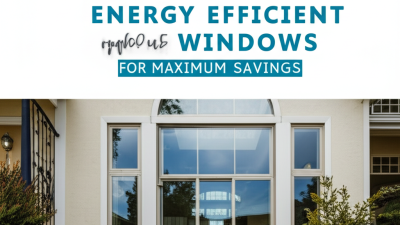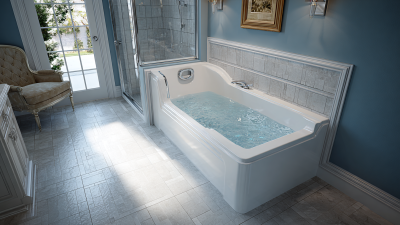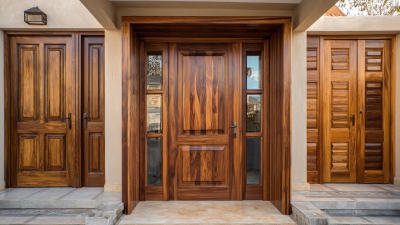Serving Minnesota & Iowa for over 25 years
Reviews
The Ultimate Guide to Choosing Energy Efficient Home Windows for Maximum Savings
Choosing the right home windows can significantly impact your energy efficiency and overall savings. In today’s eco-conscious world, understanding how to select energy-efficient windows is essential for homeowners looking to minimize energy costs while enhancing comfort. This ultimate guide outlines key factors to consider when selecting home windows, highlighting innovative tips and technologies that can lead to substantial savings. From understanding window ratings to exploring different materials and styles that best suit your needs, this comprehensive resource aims to empower you with the knowledge necessary to make informed decisions. Whether you're building a new home or renovating, the right choice in home windows not only contributes to a greener planet but also improves your living environment and adds value to your property. Discover actionable insights and expert advice that will guide you through the selection process, ensuring you achieve maximum energy efficiency and savings.

Understanding Energy Efficiency Ratings for Home Windows: A Comprehensive Overview
When selecting energy-efficient home windows, understanding energy efficiency ratings is crucial for making an informed decision. Windows are assigned various ratings, including U-factor, Solar Heat Gain Coefficient (SHGC), and Visible Transmittance (VT). The U-factor measures the rate of heat transfer; a lower value indicates better insulation, which is vital in maintaining indoor temperatures and reducing heating or cooling costs. Homeowners should aim for windows with a U-factor that meets or exceeds ENERGY STAR® standards tailored for their climate zone.
Equally important is the SHGC, which assesses how much solar radiation can pass through the window. Windows with a low SHGC are preferable for hotter climates, as they minimize heat gain, while those with a higher SHGC can be more beneficial in colder regions, allowing sunlight to warm the home. Additionally, the VT rating indicates how much natural light enters a space, balancing light and energy efficiency. By familiarizing oneself with these ratings, homeowners can choose the best windows that align with their energy savings goals and enhance their comfort.
The Impact of Window Material Choices on Home Energy Savings: Vinyl vs. Wood vs. Aluminum
When selecting energy-efficient windows for your home, the choice of materials plays a pivotal role in long-term energy savings. Vinyl windows are often lauded for their exceptional insulative properties and low maintenance requirements. They typically come with multiple chambers that trap air, providing excellent thermal resistance. Additionally, vinyl is less prone to warping and requires no painting, making it a cost-effective option over the lifespan of the windows.
In contrast, wood windows offer a classic aesthetic and natural insulation, though they usually require more upkeep. Properly treated and maintained wood windows can provide substantial energy savings, but they are susceptible to weather conditions and need regular painting and sealing to prevent deterioration. Aluminum windows, while durable and modern, tend to conduct heat more readily and have less insulating capability unless they are thermally broken. This means that while they might be appealing in design, their contribution to energy efficiency could be significantly lower compared to vinyl and wood options. When considering the impact of window material on energy savings, it is essential to weigh these factors to find the right balance between aesthetic appeal and energy efficiency for your home.
Comparative Analysis of Single, Double, and Triple Glazed Windows on Energy Performance
When considering energy-efficient home windows, a comparative analysis of single, double, and triple glazed windows can provide significant insights into energy performance. Single glazed windows, while cost-effective, often fail to provide adequate thermal resistance, leading to higher energy consumption and discomfort in varying seasonal temperatures. In contrast, double glazed windows offer improved insulation through a sealed air gap that reduces heat transfer, resulting in better energy savings. Recent studies highlight their seasonal thermal performance, taking into account factors like window opening area and solar heat gain, which can substantially impact a home's overall energy efficiency.
Triple glazed windows take energy performance a step further, with an additional layer of glass and enhanced insulation capabilities. This advancement leads to even lower heat loss, making them particularly effective in regions with extreme climates. The review of smart switchable glazing systems suggests that innovations within glazing technology can further optimize thermal performance, addressing common weaknesses associated with traditional window designs. Homeowners aiming to make informed choices about window installations will benefit from an understanding of these various glazing options and their potential to maximize long-term energy savings.
How Proper Installation Techniques Can Enhance Window Energy Efficiency and Longevity
Proper installation techniques are critical in maximizing the energy efficiency of windows in any home. Even the most energy-efficient windows can underperform if they are improperly installed. To ensure optimal performance, it is essential to follow installation guidelines that include sealing gaps, using the right flashing methods, and accurately measuring for fit. These methods prevent air leakage and water infiltration, which are common culprits in energy loss and can lead to structural damage over time.
Additionally, investing in professional installation can significantly enhance the long-term benefits of energy-efficient windows. Professionals bring experience and precision to the installation process, ensuring that the windows are set at the correct angle and alignment. This attention to detail is vital for maintaining the integrity of the window’s insulation properties. Furthermore, regular maintenance checks post-installation can help identify and rectify any issues early on, ensuring that the windows serve their purpose of conserving energy and maintaining comfort for many years.
Energy Efficiency Ratings of Different Window Types
The chart below displays the energy efficiency ratings (U-factor) of various window types commonly used in residential constructions. A lower U-factor indicates better insulating properties and energy savings.
The Role of Energy Star Certification in Selecting Energy Efficient Windows for Your Home
When selecting energy-efficient windows for your home, one of the most valuable certifications to consider is the Energy Star label. This mark signifies that the product meets stringent efficiency guidelines set by the U.S. Environmental Protection Agency. Windows with Energy Star certification are designed to reflect heat during the summer and retain warmth during the winter, significantly reducing the energy needed for heating and cooling. This not only results in lower utility bills but also contributes to a more comfortable living environment.
**Tip:** Before purchasing, ensure to check the Energy Star ratings for your local climate zone. Windows are often rated based on their performance in specific regions, so selecting those suited for your area can enhance their efficiency further.
Moreover, choosing windows with the Energy Star label often leads to eligibility for various tax credits and rebates. These financial incentives can offset initial investment costs, making the transition to energy-efficient windows even more appealing.
**Tip:** Consider working with a certified contractor who understands Energy Star products. They can help you navigate the options and ensure proper installation, maximizing the windows' performance and energy savings over time.
Related Posts
-

Exploring the Energy Efficiency Benefits of Modern Home Windows for Sustainable Living
-

Why Walk In Tubs Are the Ultimate Solution for Safe and Relaxing Bathroom Experiences
-

Exploring Step in Tub Innovations at the 2025 China Import and Export Fair
-

Exploring the Benefits of Installing French Doors Exterior for Modern Homes
-

The Ultimate Guide to Choosing the Perfect Entry Doors for Your Home Décor
-

Discover the Benefits of Walk In Tub Clearance for Seniors and Mobility Challenges